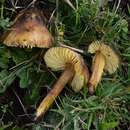pt-BR
nomes no trilho de navegação


Capel fin a 7 cm, brun, fibrilos, sliss. Lamele giàune, lìbere. Gamba àuta fin a 8 cm e larga fin a 1,2 cm, sëcca, giàuna ciàira com la carn.
A chërs ant ij pra.
![]() A venta mai mangé un bolè trovà se un a l'é nen un bon conossidor dij bolè!
A venta mai mangé un bolè trovà se un a l'é nen un bon conossidor dij bolè!
Sensa anteresse alimentar.
Capel fin a 7 cm, brun, fibrilos, sliss. Lamele giàune, lìbere. Gamba àuta fin a 8 cm e larga fin a 1,2 cm, sëcca, giàuna ciàira com la carn.
AmbientA chërs ant ij pra.
Comestibilità![]() A venta mai mangé un bolè trovà se un a l'é nen un bon conossidor dij bolè!
A venta mai mangé un bolè trovà se un a l'é nen un bon conossidor dij bolè!
Sensa anteresse alimentar.
Wilgotnica czarnobrunatna (Hygrocybe spadicea (Scop.) P. Karst.) – gatunek grzybów z rodziny wodnichowatych (Hygrophoraceae)[1].
Pozycja w klasyfikacji według Index Fungorum: Hygrocybe, Hygrophoraceae, Agaricales, Agaricomycetidae, Agaricomycetes, Agaricomycotina, Basidiomycota, Fungi[1].
Po raz pierwszy takson ten zdiagnozował w 1772 r. Joannes Antonius Scopoli nadając mu nazwę Agaricus spadiceus. Obecną, uznaną przez Index Fungorum nazwę nadał mu w 1879 r. Petter Karsten[1].
Nazwę polską nadała w 1997 r. Barbara Gumińska[3].
Średnica 3–6 cm, początkowo stożkowaty z podwiniętym brzegiem, później szeroko rozpostarty, zazwyczaj ze stożkowatym garbkiem na szczycie. Jest higrofaniczny; w stanie wilgotnym brzeg prążkowany od prześwitujących blaszek, powierzchnia śluzowata, w stanie suchym włóknista, jedwabiście błyszcząca, brunatnoczarna do prawie czarnej, na brzegu oliwkowobrunatna[4].
Prawie wolne lub zaokrąglone przy trzonie, dość grube, rzadkie, z blaszeczkami, cytrynowożółte. Ostrza równe i gładkie[4].
Wysokość 4–6 cm, średnica od 0,5 do 1 cm, walcowaty, w środku pusty. Powierzchnia bladosiarkowo-żółta, przy podstawie biała, pokryta podłużnie brązowymi włókienkami[4].
W kapeluszu cienki, kruchy, cytrynowożółty, u nasady trzonu biały, niezmieniający barwy po uszkodzeniu, bez wyraźnego zapachu i smaku[4].
Biały, zarodniki elipsoidalne, gładkie[4].
Występuje głównie w Europie, poza nią na pojedynczych stanowiskach w Ameryce Północnej i Australii[5]. W Polsce nie notowana od ponad 60 lat[3] i uznana za gatunek wymarły[6]. Znajduje się na listach gatunków zagrożonych w Szwajcarii, Niemczech, Estonii, Anglii, Norwegii, Słowacji, Szwecji, Finlandii[3].
Rozwija się wśród traw i mchów na wilgotnych łąkach i obrzeżach lasów, częściej w górach. Prawdopodobnie związana jest z wapiennym podłożem. Owocniki wytwarza od sierpnia do października[4].
Wilgotnica czarnobrunatna (Hygrocybe spadicea (Scop.) P. Karst.) – gatunek grzybów z rodziny wodnichowatych (Hygrophoraceae).